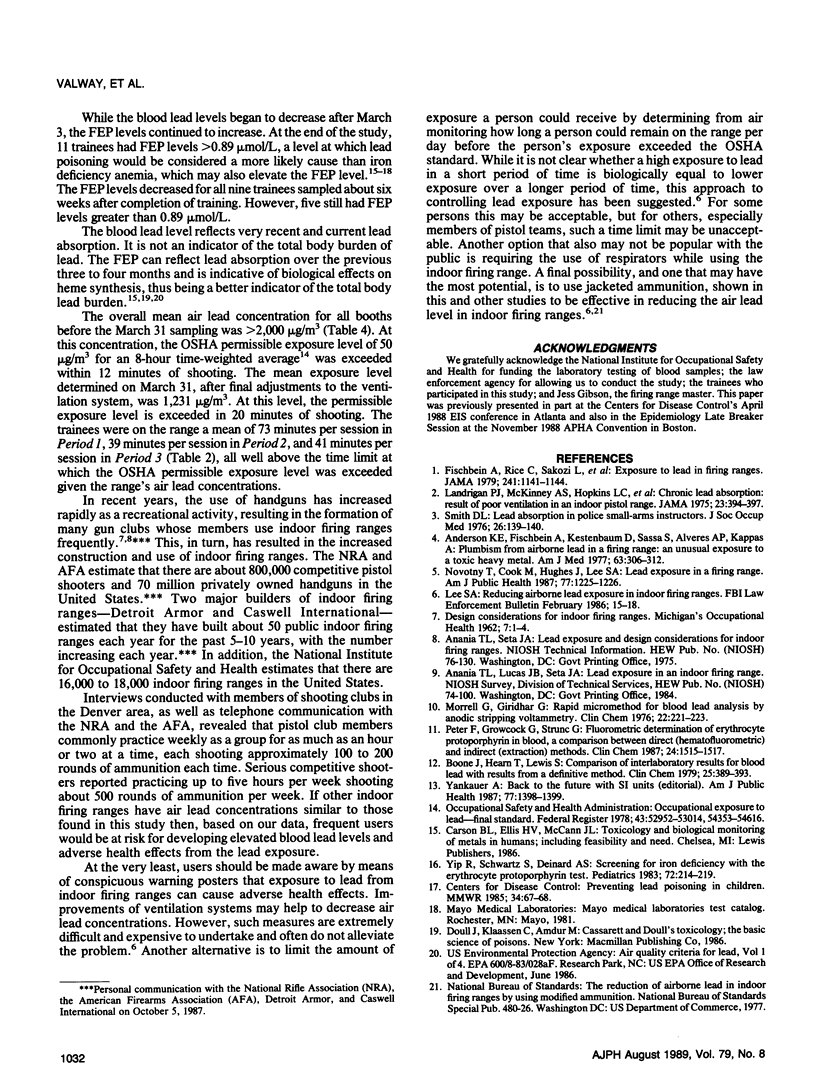Abstract
To determine if users of indoor firing ranges may be at risk from lead exposure, we studied a law enforcement trainee class during three months of firearms instruction. Blood lead levels were obtained before training and at four-week intervals during training. Air lead levels were measured three times during instruction. Blood lead levels rose from a pre-training mean of 0.31 mumol/L to 2.47 mumol/L. Mean air lead levels were above 2,000 micrograms/m3, more than 40 times the Occupational Safety and Health Administration's standard of 50 micrograms/m3. Cumulative exposure to lead and the change in blood lead were positively correlated. Control measures need to be studied to determine their efficacy in decreasing or eliminating this health risk.
Full text
PDF



Selected References
These references are in PubMed. This may not be the complete list of references from this article.
- Anderson K. E., Fischbein A., Kestenbaum D., Sassa S., Alvares A. P., Kappas A. Plumbism from airborne lead in a firing range. An unusual exposure to a toxic heavy metal. Am J Med. 1977 Aug;63(2):306–312. doi: 10.1016/0002-9343(77)90246-7. [DOI] [PubMed] [Google Scholar]
- Boone J., Hearn T., Lewis S. Comparison of interlaboratory results for blood lead with results from a definitive method. Clin Chem. 1979 Mar;25(3):389–393. [PubMed] [Google Scholar]
- Fischbein A., Rice C., Sarkozi L., Kon S. H., Petrocci M., Selikoff I. J. Exposure to lead in firing ranges. JAMA. 1979 Mar 16;241(11):1141–1144. [PubMed] [Google Scholar]
- Landrigan P. J., McKinney A. S., Hopkins L. C., Rhodes W. W., Jr, Price W. A., Cox D. H. Chronic lead absorption. Result of poor ventilation in an indoor pistol range. JAMA. 1975 Oct 27;234(4):394–397. doi: 10.1001/jama.234.4.394. [DOI] [PubMed] [Google Scholar]
- Morrell G., Giridhar G. Rapid micromethod for blood lead analysis by anodic stripping voltammetry. Clin Chem. 1976 Feb;22(2):221–223. [PubMed] [Google Scholar]
- Novotny T., Cook M., Hughes J., Lee S. A. Lead exposure in a firing range. Am J Public Health. 1987 Sep;77(9):1225–1226. doi: 10.2105/ajph.77.9.1225. [DOI] [PMC free article] [PubMed] [Google Scholar]
- Peter F., Growcock G., Strunc G. Fluorometric determination of erythrocyte protoporphyrin in blood, a comparison between direct (hematofluorometric) and indirect (extraction) methods. Clin Chem. 1978 Sep;24(9):1515–1517. [PubMed] [Google Scholar]
- Smith D. L. Lead absorption in police small-arms instructors. J Soc Occup Med. 1976 Oct;26(4):139–140. doi: 10.1093/occmed/26.4.139. [DOI] [PubMed] [Google Scholar]
- Yankauer A. Back to the future with SI units. Am J Public Health. 1987 Nov;77(11):1398–1399. doi: 10.2105/ajph.77.11.1398. [DOI] [PMC free article] [PubMed] [Google Scholar]
- Yip R., Schwartz S., Deinard A. S. Screening for iron deficiency with the erythrocyte protoporphyrin test. Pediatrics. 1983 Aug;72(2):214–219. [PubMed] [Google Scholar]


